PORSCHE 911 2009 5.G Information Manual
Manufacturer: PORSCHE, Model Year: 2009, Model line: 911, Model: PORSCHE 911 2009 5.GPages: 59, PDF Size: 5.74 MB
Page 21 of 59
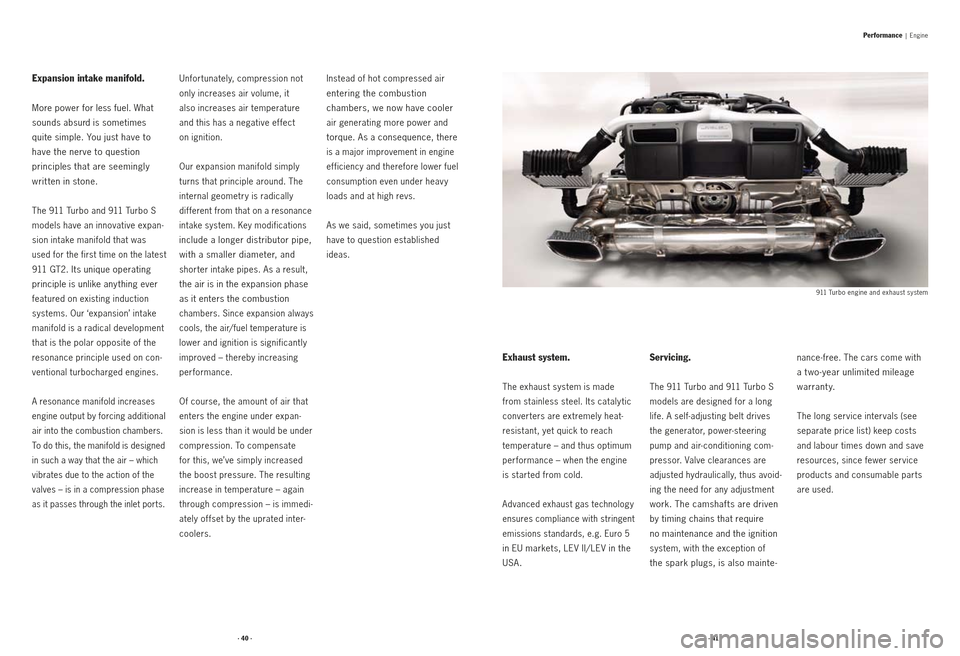
Expansion intake manifold.
More power for less fuel. What
sounds absurd is sometimes
quite simple. You just have to
have the nerve to question
prin ciples that are seemingly
writ ten in stone.
The 911 Turbo and 911 Turbo S
models have an innovative expan -
sion intake manifold that was
used for the first time on the latest
911 GT2. Its unique operating
principle is unlike any thing ever
featured on existing induction
systems. Our ‘expansion’ intake
manifold is a radical development
that is the polar opposite of the
resonance principle used on con -
ventional turbocharged engines.
A resonance manifold increases
engine output by forcing addi
tional
air into the combustion chambers.
To do this, the manifold is designed
in such a way that the air – which
vibrates due to the action of the
valves – is in a compression phase
as it passes through the inlet ports.
Unfortunately, compression not
only increases air volume, it
also increases air temperature
and this has a negative effect
on ignition.
Our expansion manifold simply
turns that principle around. The
internal geometry is radically
different from that on a resonance
intake system. Key modifications
include a longer distributor pipe,
with a smaller diameter, and
shorter intake pipes. As a result,
the air is in the expansion phase
as it enters the combustion
chambers. Since expansion always
cools, the air/fuel temperature is
lower and ignition is significantly
improved – thereby increasing
performance.
Of course, the amount of air that
enters the engine under expan -
sion is less than it would be under
compression. To compensate
for this, we’ve simply increased
the boost pressure. The resulting
increase in temperature – again
through compression – is immedi -
ately offset by the uprated inter -
coolers. Instead of hot compressed air
entering the combustion
chambers, we now have cooler
air generating more power and
torque. As a consequence, there
is a major improvement in engine
efficiency and therefore lower fuel
consumption even under heav y
loads and at high revs.
As we said, sometimes you just
have to question established
ideas.
Exhaust system.
The exhaust system is made
from stainless steel. Its cataly tic
converters are extremely heat-
resistant, yet quick to reach
temperature – and thus optimum
performance – when the engine
is started from cold.
Advanced exhaust gas technology
ensures compliance with stringent
emissions standards, e.g. Euro 5
in EU markets, LEV II/ LEV in the
USA.
Servicing.
The 911 Turbo and 911 Turbo S
models are designed for a long
life. A self-adjusting belt drives
the generator, power-steering
pump and air-conditioning com -
pressor. Valve clearances are
adjusted hydraulically, thus avoid -
ing the need for any adjustment
work. The camshafts are driven
by timing chains that require
no maintenance and the ignition
system, with the exception of
the spark plugs, is also mainte -
nance-free. The cars come with
a t wo -year unlimited mileage
w a r ra n t y.
The long service intervals (see
separate price list) keep costs
and labour times down and save
resources, since fewer service
products and consumable parts
are used.
Performance | Engine
911 Turbo engine and exhaust system
· 40 ·· 41 ·
Page 22 of 59
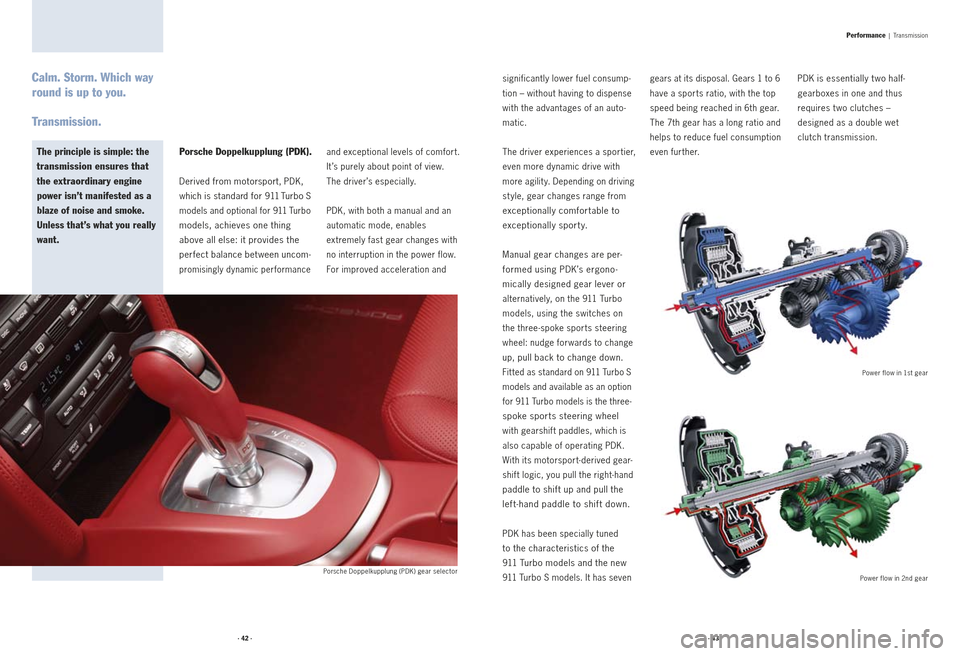
Porsche Doppelkupplung (PDK).
Derived from motorsport, PDK,
which is standard for 911 Turbo S
models and optional for 911 Turbo
models, achieves one thing
above all else: it provides the
perfect balance bet ween uncom -
promisingly dynamic performance
and exceptional levels of comfort.
It ’s purely about point of view.
The driver’s especially.
PDK, with both a manual and an
automatic mode, enables
extremely fast gear changes with
no interruption in the power flow.
For improved acceleration and significantly lower fuel consump
-
tion – without having to dispense
with the advantages of an auto -
matic.
The driver experiences a sportier,
even more dynamic drive with
more agilit y. Depending on driving
st yle, gear changes range from
exceptionally comfortable to
exceptionally sport y.
Manual gear changes are per -
formed using PDK’s ergono-
mically
designed gear lever or
alternatively, on the 911 Turbo
models, using the switches on
the three-spoke sports steering
wheel: nudge forwards to change
up, pull back to change down.
Fit ted as standard on 911 Turbo S
models and available as an option
for 911 Turbo models is the three-
spoke sports steering wheel
with gearshif t paddles, which is
also capable of operating PDK.
With its motorsport-derived gear -
shif t logic, you pull the right-hand
paddle to shift up and pull the
left-hand paddle to shift down.
PDK has been specially tuned
to the characteristics of the
911
Turbo models and the new
911 Turbo S models. It has seven
gears at its disposal. Gears 1 to 6
have a sports ratio, with the top
speed being reached in 6th gear.
The 7th gear has a long ratio and
helps to reduce fuel consumption
even further.
PDK is essentially t wo half-
gearboxes in one and thus
requires t wo clutches –
designed as a double wet
clutch transmission.
The principle is simple: the
transmission ensures that
the extraordinary engine
power isn’t manifested as a
blaze of noise and smoke.
Unless that’s what you really
want.
Calm. Storm. Which way
round is up to you.
Transmission.
Porsche Doppelkupplung (PDK) gear selector Power flow in 1st gear
Power flow in 2nd gear
Performance | Transmission
· 42 ·· 43 ·
Page 23 of 59
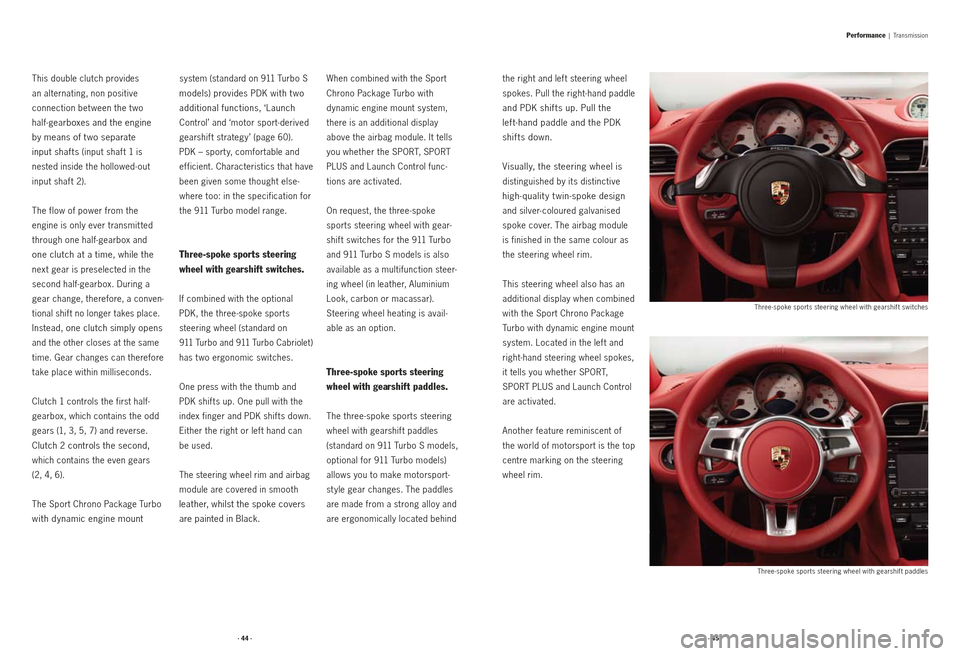
This double clutch provides
an alternating, non positive
connection bet ween the t wo
half-gear
boxes and the engine
by means of t wo separate
input shafts
(input shaf t 1 is
nested inside the hollowed- out
input shaft 2).
The flow of power from the
engine is only ever transmit ted
through one half-gearbox and
one clutch at a time, while the
next gear is preselected in the
second half-gearbox. During a
gear change, therefore, a conven -
tional shift no longer takes place.
Instead, one clutch simply opens
and the other closes at the same
time. Gear changes can therefore
take place within milliseconds.
Clutch 1 controls the first half-
gearbox, which contains the odd
gears (1, 3, 5, 7) and reverse.
Clutch 2 controls the second,
which contains the even gears
(2, 4, 6).
The Sport Chrono Package Turbo
with dynamic engine mount system (standard on 911 Turbo S
models) provides PDK with t wo
additional functions, ‘Launch
Control’ and ‘motor sport- derived
gearshif t strategy’ (page 60).
PDK – sport y, comfortable and
ef ficient. Characteristics that have
been given some thought else -
where too: in the specification for
the 911 Turbo model range.
Three-spoke sports steering
wheel with gearshift switches.
If combined with the optional
PDK, the three-spoke sports
steering wheel (standard on
911 Turbo and 911 Turbo Cabriolet)
has t wo ergonomic switches.
One press with the thumb and
PDK shif ts up. One pull with the
index finger and PDK shifts down.
Either the right or lef t hand can
be used.
The steering wheel rim and airbag
module are covered in smooth
leather, whilst the spoke covers
are painted in Black.
When combined with the Sport
Chrono Package Turbo with
dynamic engine mount system,
there is an additional display
above the airbag module. It tells
you whether the SPORT, SPORT
PLUS and Launch Control func -
tions are activated.
On request, the three-spoke
sports steering wheel with gear -
shift switches for the 911 Turbo
and 911 Turbo S models is also
available as a multifunction steer -
ing wheel (in leather, Aluminium
Look, carbon or macassar).
Steering wheel heating is avail -
able as an option.
Three-spoke sports steering
wheel with gearshift paddles.
The three-spoke sports steering
wheel with gearshif t paddles
(standard on 911 Turbo S models,
optional for 911 Turbo models)
allows you to make motorsport-
st yle gear changes. The paddles
are made from a strong alloy and
are ergonomically located behind the right and lef t steering wheel
spokes. Pull the right-hand paddle
and PDK shifts up. Pull the
left-hand paddle and the PDK
shifts down.
Visually, the steering wheel is
distinguished by its distinctive
high-qualit y t win-spoke design
and silver-coloured galvanised
spoke cover. The airbag module
is finished in the same colour as
the steering wheel rim.
This steering wheel also has an
additional display when combined
with the Sport Chrono Package
Turbo with dynamic engine mount
system. Located in the lef t and
right-hand steering wheel spokes,
it tells you whether SPORT,
SPORT PLUS and Launch Control
are activated.
Another feature reminiscent of
the world of motorsport is the top
centre marking on the steering
wheel rim.
Three -spoke sports steering wheel with gearshif t switches
Three -spoke sports steering wheel with gearshif t paddles
Performance | Transmission
· 44 ·· 45 ·
Page 24 of 59
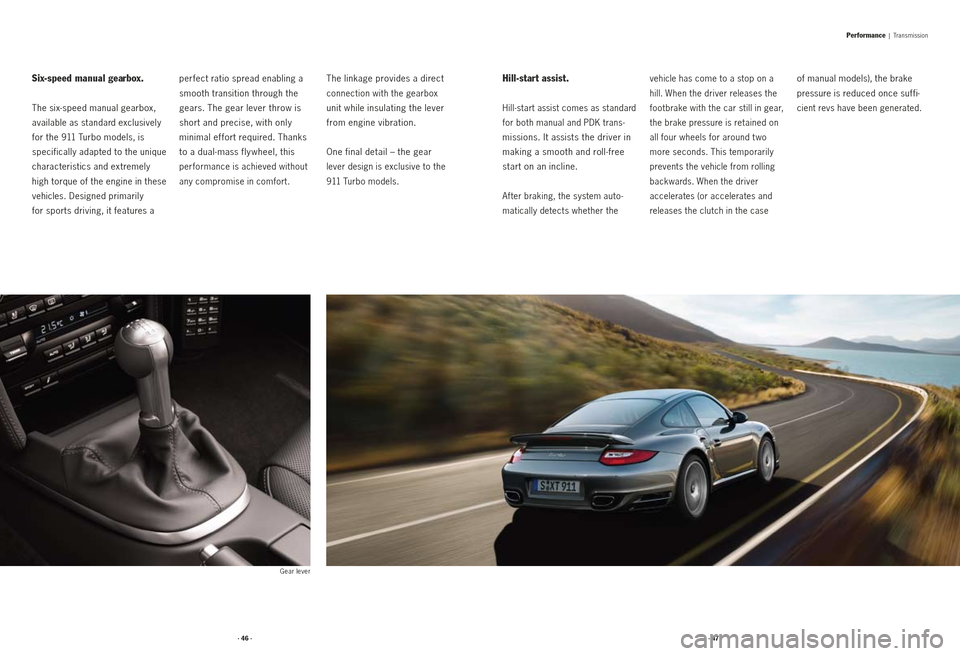
perfect ratio spread enabling a
smooth transition through the
gears. The gear lever throw is
short and precise, with only
minimal effort required. Thanks
to a dual-mass fly wheel, this
performance is achieved without
any compromise in comfort.
The linkage provides a direct
connection with the gearbox
unit while insulating the lever
from engine vibration.
One final detail – the gear
lever design is exclusive to the
911 Turbo models.
Six-speed manual gearbox.
The six-speed manual gearbox,
available as standard exclusively
for the 911 Turbo models, is
specifically adapted to the unique
characteristics and extremely
high torque of the engine in these
vehicles. Designed primarily
for sports driving, it features a
Hill-start assist.
Hill-start assist comes as standard
for both manual and PDK trans -
missions. It assists the driver in
making a smooth and roll-free
start on an incline.
After braking, the system auto-
matically detects whether the
of manual models), the brake
pressure is reduced once suffi -
cient revs have been generated.
Gear lever
vehicle has come to a stop on a
hill. When the driver releases the
footbrake with the car still in gear,
the brake pressure is retained on
all four wheels for around t wo
more seconds. This temporarily
prevents the vehicle from rolling
backwards. When the driver
accelerates (or accelerates and
releases the clutch in the case
Performance | Transmission
· 46 ·· 47 ·
Page 25 of 59
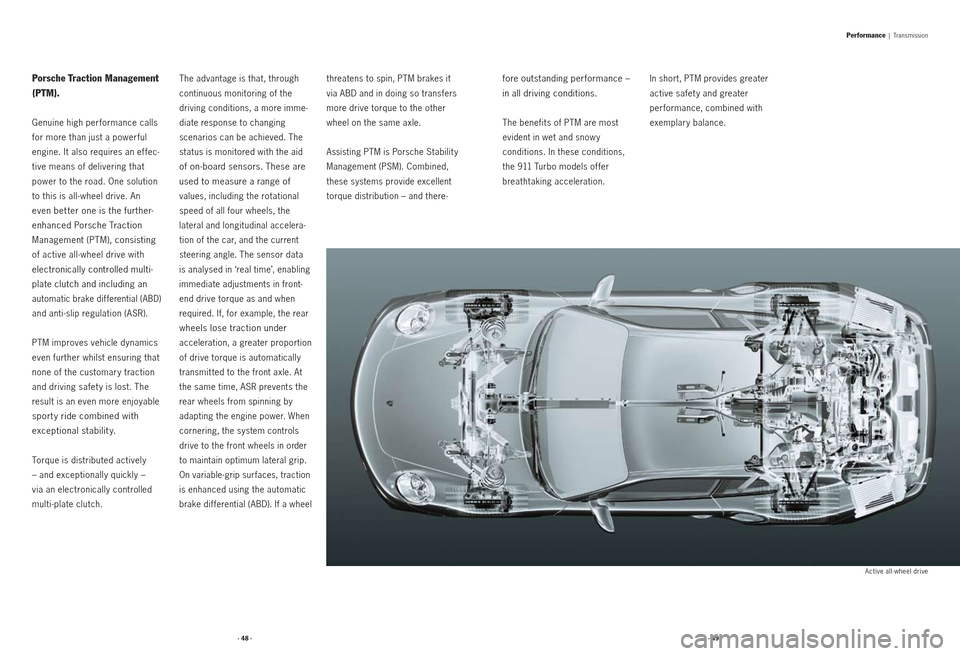
Porsche Traction Management
(P TM).
Genuine high per formance calls
for more than just a power ful
engine. It also requires an ef fec-
tive means of delivering that
power to the road. One solution
to this is all -wheel drive. An
even bet ter one is the further-
enhanced Porsche Traction
Management (PTM), consisting
of active all -wheel drive with
electronically controlled multi -
plate clutch and including an
automatic brake differential (ABD)
and anti -slip regulation (ASR).
PTM improves vehicle dynamics
even further whilst ensuring that
none of the customar y traction
and driving safet y is lost. The
result is an even more enjoyable
sport y ride combined with
exceptional stability.
Torque is distributed actively
– and exceptionally quickly –
via an electronically controlled
multi-plate clutch. The advantage is that, through
continuous monitoring of the
driving conditions, a more imme -
diate response to changing
scenarios can be achieved. The
status is monitored with the aid
of on-board sensors. These are
used to measure a range of
values, including the rotational
speed of all four wheels, the
lateral and longitudinal accelera -
tion of the car, and the current
steering angle. The sensor data
is analysed in ‘real time’, enabling
immediate adjustments in front-
end drive torque as and when
required. If, for example, the rear
wheels lose traction under
acceleration, a greater proportion
of drive torque is automatically
transmit ted to the front axle. At
the same time, ASR prevents the
rear wheels from spinning by
adapting the engine power. When
cornering, the system controls
drive to the front wheels in order
to maintain optimum lateral grip.
On variable-grip surfaces, traction
is enhanced using the automatic
brake dif ferential (ABD). If a wheel threatens to spin, PTM brakes it
via ABD and in doing so transfers
more drive torque to the other
wheel on the same axle.
Assisting PTM is Porsche Stabilit y
Management (PSM). Combined,
these systems provide excellent
torque distribution – and there
-
fore outstanding performance –
in all driving conditions.
The benefits of PTM are most
evident in wet and snow y
conditions. In these conditions,
the 911 Turbo models of fer
breathtaking acceleration. In short, PTM provides greater
active safet y and greater
performance, combined with
exemplary balance.
Performance | Transmission
Active all -wheel drive
· 48 ·· 49 ·
Page 26 of 59
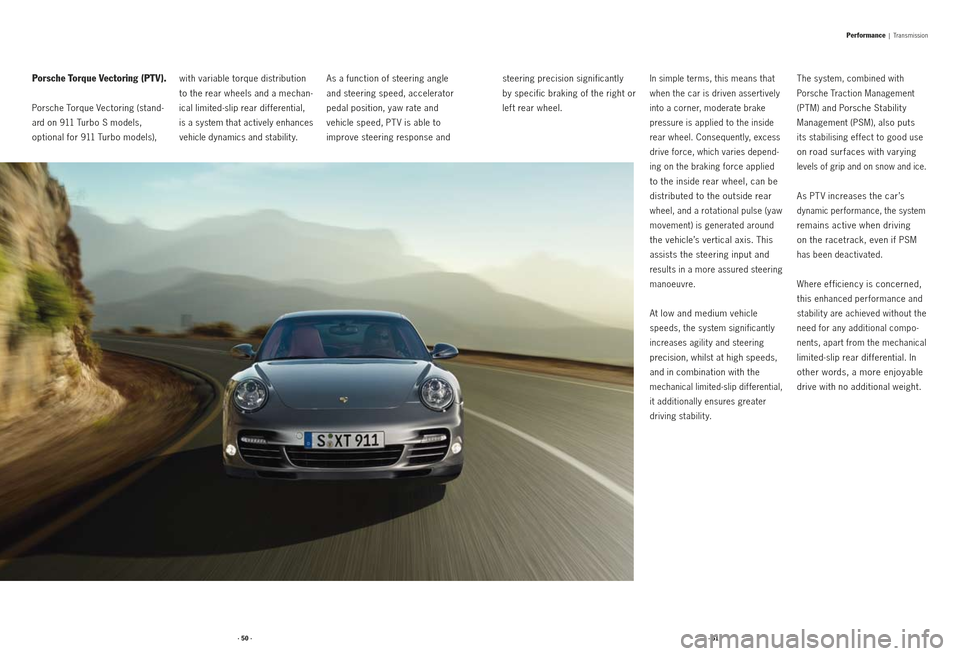
Porsche Torque Vectoring (PTV).
Porsche Torque Vectoring (stand-
ard on 911 Turbo S models,
optional for 911 Turbo models), with variable torque distribution
to the rear wheels and a mechan
-
ical limited-slip rear differential,
is a system that actively enhances
vehicle dynamics and stabilit y. As a function of steering angle
and steering speed, accelerator
pedal position, yaw rate and
vehicle speed, PT V is able to
improve steering response and steering precision significantly
by specific braking of the right or
left rear wheel.
In simple terms, this means that
when the car is driven assertively
into a corner, moderate brake
pressure is applied to the inside
rear wheel. Consequently, excess
drive force, which varies depend -
ing on the braking force applied
to the inside rear wheel, can be
distributed to the outside rear
wheel, and a rotational pulse (yaw
movement) is generated around
the vehicle’s vertical axis. This
assists the steering input and
results in a more assured steering
manoeuvre.
At low and medium vehicle
speeds, the system significantly
increases agilit y and steering
precision, whilst at high speeds,
and in combination with the
mechanical limited-slip differential,
it additionally ensures greater
driving stabilit y. The system, combined with
Porsche Traction Management
(PTM) and Porsche Stabilit y
Management (PSM), also puts
its stabilising ef fect to good use
on road surfaces with varying
levels of grip and on snow and ice.
As PT V increases the car’s
dynamic performance, the system
remains active when driving
on the racetrack, even if PSM
has been deactivated.
Where
efficien cy is concerned,
this
enhanced performance and
stabilit y are achieved without the
need for any additional compo -
nents, apart from the mechanical
limited-slip rear differential. In
other words, a more enjoyable
drive with no additional weight.
Performance | Transmission
· 50 ·· 51 ·
Page 27 of 59
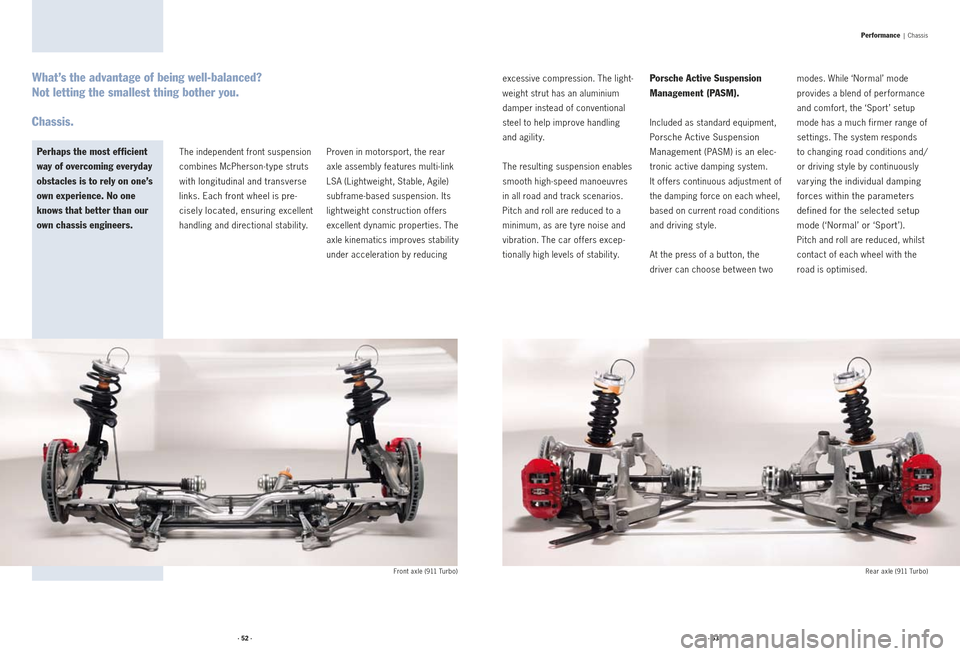
The independent front suspension
combines McPherson-type struts
with longitudinal and transverse
links. Each front wheel is pre-
cisely located, ensuring excellent
handling and directional stabilit y. Proven in motorsport, the rear
axle assembly features multi-link
LSA (Light weight, Stable, Agile)
subframe-based suspension. Its
light weight construction of fers
excellent dynamic properties. The
axle kinematics improves stabilit y
under acceleration by reducing excessive compression. The light
-
weight strut has an aluminium
damper instead of conventional
steel to help improve handling
and agility.
The resulting suspension enables
smooth high -speed manoeuvres
in all road and track scenarios.
Pitch and roll are reduced to a
minimum, as are t yre noise and
vibration. The car offers excep -
tionally high levels of stabilit y.
Porsche Active Suspension
Management (PASM).
Included as standard equipment,
Porsche Active Suspension
Management (PASM) is an elec -
tronic active damping system.
It of fers continuous adjustment of
the damping force on each wheel,
based on current road conditions
and driving st yle.
At the press of a but ton, the
driver can choose bet ween t wo modes. While ‘Normal’ mode
provides a blend of performance
and comfort, the ‘Sport ’ setup
mode has a much firmer range of
set tings. The system responds
to changing road conditions and/
or driving st yle by continuously
varying the individual damping
forces within the parameters
defined for the selected setup
mode (‘Normal’ or ‘Sport ’).
Pitch and roll are reduced, whilst
contact of each wheel with the
road is optimised.
What’s the advantage of being well-balanced?
Not letting the smallest thing bother you.
Chassis.
Perhaps the most efficient
way of overcoming everyday
obstacles is to rely on one’s
own experience. No one
knows that better than our
own chassis engineers.
Front axle (911 Turbo) Rear axle (911 Turbo)
Performance | Chassis
· 52 ·· 53 ·
Page 28 of 59
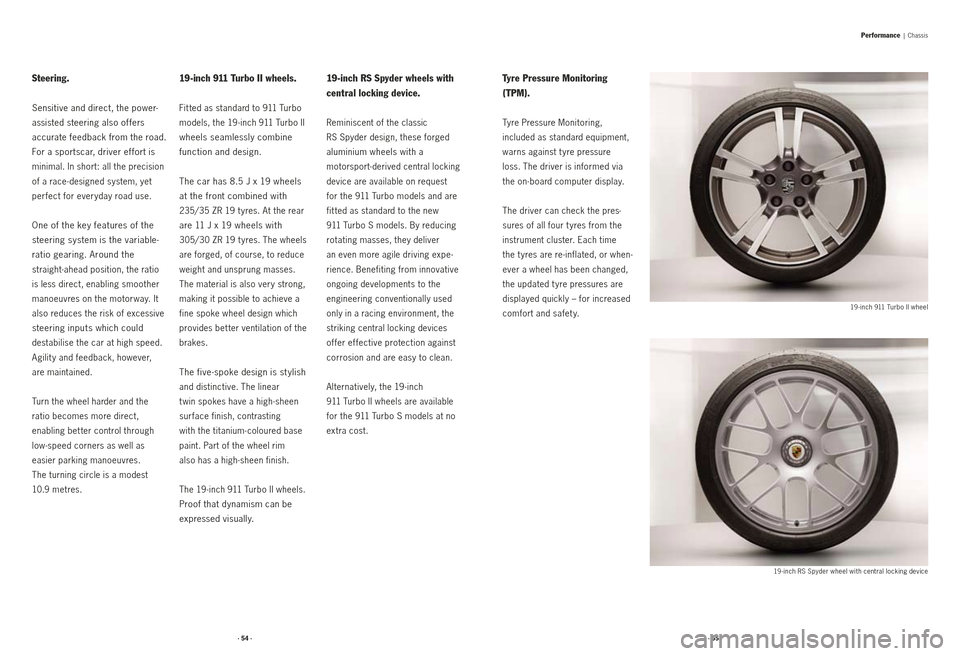
Steering.
Sensitive and direct, the power-
assisted steering also of fers
accurate feedback from the road.
For a sportscar, driver effort is
minimal. In short: all the precision
of a race- designed system, yet
perfect for everyday road use.
One of the key features of the
steering system is the variable-
ratio gearing. Around the
straight-ahead position, the ratio
is less direct, enabling smoother
manoeuvres on the motorway. It
also reduces the risk of excessive
steering inputs which could
destabilise the car at high speed.
Agilit y and feedback, however,
are maintained.
Turn the wheel harder and the
ratio becomes more direct,
enabling bet ter control through
low-speed corners as well as
easier parking manoeuvres.
The turning circle is a modest
10.9 metres.
19-inch 911 Turbo II wheels.
Fit ted as standard to 911 Turbo
models, the 19 -inch 911 Turbo II
wheels seamlessly combine
function and design.
The car has 8.5 J x 19 wheels
at the front combined with
235/35 ZR 19 t yres. At the rear
are 11 J x 19 wheels with
305/30 ZR 19 t yres. The wheels
are forged, of course, to reduce
weight and unsprung masses.
The material is also very strong,
making it possible to achieve a
fine spoke wheel design which
provides bet ter ventilation of the
brakes.
The five-spoke design is st ylish
and distinctive. The linear
t win spokes have a high -sheen
surface finish, contrasting
with the titanium - coloured base
paint. Part of the wheel rim
also has a high -sheen finish.
The 19 -inch 911 Turbo II wheels.
Proof that dynamism can be
expressed visually.
19-inch RS Spyder wheels with
central locking device.
Reminiscent of the classic
RS Spyder design, these forged
aluminium wheels with a
motorsport-derived central locking
device are available on request
for the 911 Turbo models and are
fit ted as standard to the new
911 Turbo S models. By reducing
rotating masses, they deliver
an even more agile driving expe -
rience. Benefiting from innovative
ongoing developments to the
engineering conventionally used
only in a racing environment, the
striking central locking devices
of fer ef fective protection against
corrosion and are easy to clean.
Alternatively, the 19 -inch
911 Turbo II wheels are available
for the 911 Turbo S models at no
extra cost.
Tyre Pressure Monitoring
(TPM).
Tyre Pressure Monitoring,
included as standard equipment,
warns against t yre pressure
loss. The driver is informed via
the on -board computer display.
The driver can check the pres -
sures of all four t yres from the
instrument cluster. Each time
the t yres are re-inflated, or when -
ever a wheel has been changed,
the updated t yre pressures are
displayed quickly – for increased
comfort and safet y.
19 - inch 911 Turbo II wheel
19 - inch RS Spyder wheel with central locking device
Performance | Chassis
· 54 ·· 55 ·
Page 29 of 59
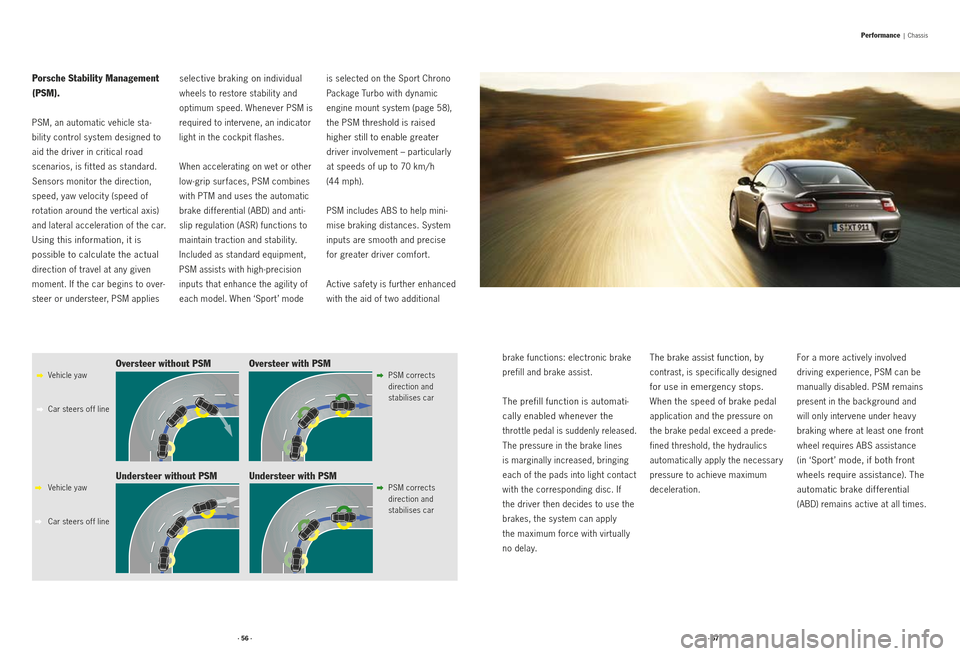
Porsche Stability Management
(PSM).
PSM, an automatic vehicle sta-
bilit y control system designed to
aid the driver in critical road
scenarios, is fit ted as standard.
Sensors monitor the direction,
speed, yaw velocit y (speed of
rotation around the vertical axis)
and lateral acceleration of the car.
Using this information, it is
possible to calculate the actual
direction of travel at any given
moment. If the car begins to over -
steer or understeer, PSM applies
selective braking on individual
wheels to restore stabilit y and
optimum speed. Whenever PSM is
required to intervene, an indicator
light in the cockpit flashes.
When accelerating on wet or other
low-grip surfaces, PSM combines
with PTM and uses the automatic
brake differential (ABD) and anti-
slip regulation (ASR) functions to
maintain traction and stabilit y.
Included as standard equipment,
PSM assists with high -precision
inputs that enhance the agilit y of
each model. When ‘Sport ’ mode is selected on the Sport Chrono
Package Turbo with dynamic
engine mount system (page 58),
the PSM threshold is raised
higher still to enable greater
driver involvement – particularly
at speeds of up to 70 km/ h
(44 mph).
PSM includes ABS to help mini -
mise braking distances. System
inputs are smooth and precise
for greater driver comfort.
Active safet y is further enhanced
with the aid of t wo additional
brake functions: electronic brake
prefill and brake assist.
The prefill function is automati-
cally enabled whenever the
throt tle pedal is suddenly released.
The pressure in the brake lines
is marginally increased, bringing
each of the pads into light contact
with the corresponding disc. If
the driver then decides to use the
brakes, the system can apply
the maximum force with virtually
no delay.
The brake assist function, by
contrast, is specifically designed
for use in emergency stops.
When the speed of brake pedal
application and the pressure on
the brake pedal exceed a prede -
fined threshold, the hydraulics
automatically apply the necessary
pressure to achieve maximum
deceleration. For a more actively involved
driving experience, PSM can be
manually disabled. PSM remains
present in the background and
will only intervene under heav y
braking where at least one front
wheel requires ABS assistance
(in ‘Sport ’ mode, if both front
wheels require assistance). The
automatic brake differential
(ABD) remains active at all times.
Vehicle yaw
Car steers of f line
Vehicle yaw
Car steers of f line PSM corrects
direction and
stabilises car
PSM corrects
direction and
stabilises carOversteer without PSM
Oversteer with PSM
Understeer with PSM
Understeer without PSM
Performance | Chassis
· 56 ·· 57 ·
Page 30 of 59
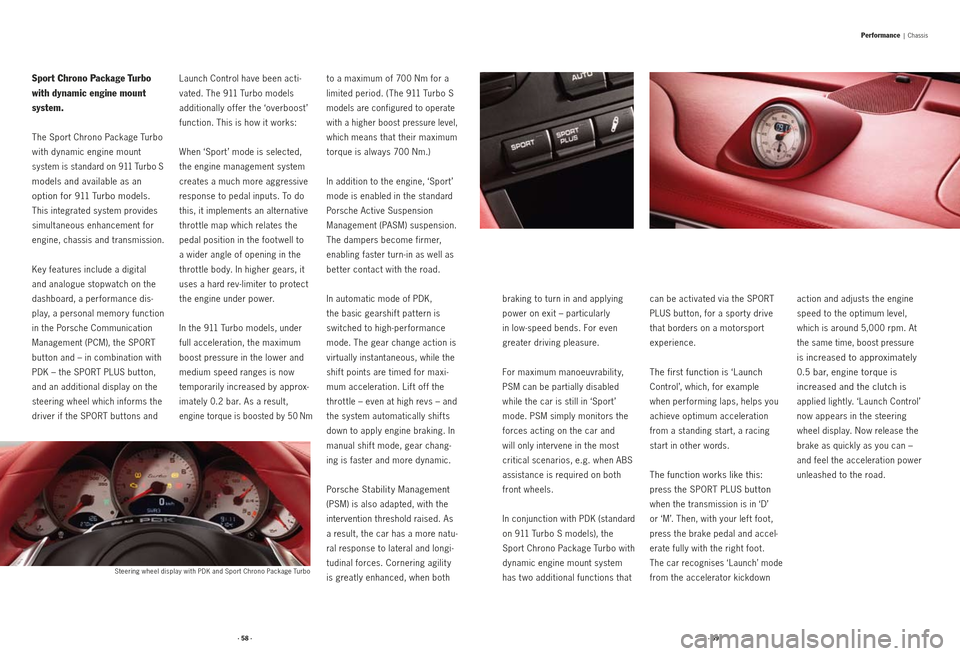
Sport Chrono Package Turbo
with dynamic engine mount
system.
The Sport Chrono Package Turbo
with dynamic engine mount
system is standard on 911 Turbo S
models and available as an
option for 911 Turbo models.
This integrated system provides
simultaneous enhancement for
engine, chassis and transmission.
Key features include a digital
and analogue stopwatch on the
dashboard, a performance dis -
play, a personal memor y function
in the Porsche Communication
Management (PCM), the SPORT
but ton and – in combination with
PDK – the SPORT PLUS but ton,
and an additional display on the
steering wheel which informs the
driver if the SPORT but tons and Launch Control have been acti
-
vated. The 911 Turbo models
additionally of fer the ‘overboost ’
function. This is how it works:
When ‘Sport ’ mode is selected,
the engine management system
creates a much more aggressive
response to pedal inputs. To do
this, it implements an alternative
throt tle map which relates the
pedal position in the foot well to
a wider angle of opening in the
throt tle body. In higher gears, it
uses a hard rev- limiter to protect
the engine under power.
In the 911 Turbo models, under
full acceleration, the maximum
boost pressure in the lower and
medium speed ranges is now
temporarily increased by approx -
imately 0.2 bar. As a result,
engine torque is boosted by 50 Nm to a maximum of 700 Nm for a
limited period. (The 911 Turbo S
models are configured to operate
with a higher boost pressure level,
which means that their maximum
torque is always 700 Nm.)
In addition to the engine, ‘Sport ’
mode is enabled in the standard
Porsche Active Suspension
Management (PASM) suspension.
The dampers become firmer,
enabling faster turn - in as well as
bet ter contact with the road.
In automatic mode of PDK,
the basic gearshif t pat tern is
switched to high-performance
mode. The gear change action is
virtually instantaneous, while the
shift points are timed for maxi -
mum acceleration. Lif t of f the
throt tle – even at high revs – and
the system automatically shif ts
down to apply engine braking. In
manual shif t mode, gear chang -
ing is faster and more dynamic.
Porsche Stabilit y Management
(PSM) is also adapted, with the
intervention threshold raised. As
a result, the car has a more natu -
ral response to lateral and longi -
tudinal forces. Cornering agilit y
is greatly enhanced, when both braking to turn in and applying
power on exit – particularly
in low-speed bends. For even
greater driving pleasure.
For maximum manoeuvrabilit y,
PSM can be partially disabled
while the car is still in ‘Sport ’
mode. PSM simply monitors the
forces acting on the car and
will only intervene in the most
critical scenarios, e.g. when ABS
assistance is required on both
front wheels.
In conjunction with PDK (standard
on 911 Turbo S models), the
Sport Chrono Package Turbo with
dynamic engine mount system
has t wo additional functions that can be activated via the SPORT
PLUS but ton, for a sport y drive
that borders on a motorsport
experience.
The first function is ‘Launch
Control’, which, for example
when per forming laps, helps you
achieve optimum acceleration
from a standing start, a racing
start in other words.
The function works like this:
press the SPORT PLUS but ton
when the transmission is in ‘D’
or ‘M’. Then, with your lef t foot,
press the brake pedal and accel -
erate fully with the right foot.
The car recognises ‘Launch’ mode
from the accelerator kickdown action and adjusts the engine
speed to the optimum level,
which is around 5,000 rpm. At
the same time, boost pressure
is increased to approximately
0.5 bar, engine torque is
increased and the clutch is
applied lightly. ‘Launch Control’
now appears in the steering
wheel display. Now release the
brake as quickly as you can –
and feel the acceleration power
unleashed to the road.
Steering wheel display with PDK and Sport Chrono Package Turbo
Performance | Chassis
· 58 ·· 59 ·